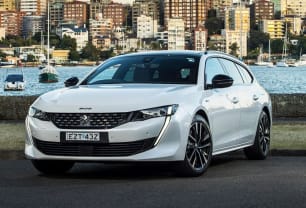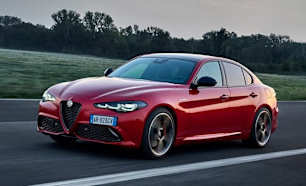The front row gets the most space and you’ll be able to get into a comfortable position even if you’re tall.
However, it is a low car with its 142mm ground clearance and there may be a few grunts as you get in and out (or is it just me?).
My seven-year old loves how easy it is to climb in, though he didn’t have the best view out of the windows because the sills sit high.
The footwell lip also sits quite high, which isn’t an issue until you can’t open your door very wide and then it’s clumsy in a tight parking space.
The electric front seats are very comfortable and the extendable under-thigh support helps to minimise leg fatigue on a longer journey.
Surprisingly, for my 168cm (5'6") height, I have to sit much further back than I ordinarily would to get a comfy driving position.
In the back, you have plenty of headroom but behind my driving position, the legroom could be better.
An adult would still find it fairly comfortable on a longer journey so long as they aren’t behind someone tall. The seats themselves are well-cushioned and you sit in, rather than on top of them.
Individual storage options are good for this class with a dual-opening middle console, glove box and a great utility cubby next to the transmission shifter.
There is also a shelf underneath the centre console that houses the wireless charging pad and two USB-A ports but it’s a tad awkward to use and even see the ports when you're seated.
The amenities are good in the rear but for a top-spec model it’s lacking the luxury items you might expect, like heated seats and climate control but you’ll enjoy map pockets, reading lights, two USB-A ports and directional air vents.
It also has a fold-down armrest with two shallow cupholders, that in a quick turn, might spill their cups!
The boot is a great size at 530L with all seats in use and you can bump it to 1780L with the rear seats folded.
You get a level loading space and a 60/40 split with a ski-port in the back seat, which opens up your storage options.
There is a tyre repair kit rather than a physical spare but the tailgate is powered, which I always like.
The technology is a mixed bag. It looks sharp and the touchscreen multimedia system is responsive but isn’t as easy to use as others I’ve sampled.
It doesn’t have a lot of accessible information or customisations available but it is easy to connect to the wired Apple CarPlay. There is also wired Android Auto for those users and built-in satellite navigation.
The 12.3-inch digital instrument panel is the prettiest piece of tech in the car and there is more customisation available to make it feel yours.
Considering its price point and top-model status, it's more obvious that you miss out on premium items like three-zone climate control, faster USB-C connections and a head-up display.

